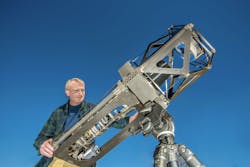National Lab Tackles Design Project Using 3D Printing
A Sandia National Laboratories team decided to design and build a telescope, with a focus on taking advantage of 3D printing’s strengths while avoiding its weaknesses. The purpose of the project was to treat 3D printing as an entirely new design tool, vastly different from the standard technique of moving from hand drawing to computer-assisted design to machining parts, says Ted Winrow, the mechanical engineer who led the project.
Instead of concentrating on printing precision parts, the project focused on how to put together less-precise 3D printed parts using precise tools, taking advantage of the rapid prototyping, design, and manufacturing possible with 3D printing.
“That’s the nuance that seems to get lost–that you have to design differently for 3D printers,” Winrow said. “They just don’t plug into standard design processes.”
Sandia National Laboratories project lead and mechanical engineer Ted Winrow with the telescope he and his team built using 3D orienting and advanced manufacturing techniques. (Photo by Randy Montoya)
The team ended up with a lighter-weight, less-expensive, ground-based telescope in about a third of the time it would take to build a traditionally made telescope and for only for about a fifth of the cost, he said.
“The technique shifts money from recurring costs, in which every part has to be precise, to nonrecurring costs, where you’re just buying a set of precision tools you can use for 10 years,” Winrow explained. “So when you’re making production runs, you get cost savings. And you’ve got time savings because you’re not waiting for each piece to be made by machining.”
There are two ways to approach building any precision structure: make every piece to exact tolerances so assembly is simple, or make rougher pieces and use a precise assembly process that compensates for shortfalls in precise dimensions.
Machining creates parts with extremely precise dimensions, but it can’t cheaply make–or in some cases, make at all–the 3D-printed parts that may have advantages in function and weight. Design, however, is a separate question.
Expanded detail view of the telescope created by a Sandia National Laboratories team using additive manufacturing techniques.
Can you design a finished product that doesn’t care that your parts aren’t dimensionally accurate?” Winrow asked. “If you ignore the processes that 3D printing is not good at, you can take advantage of what it’s good at.”
For example, standard cameras have a ledge and must be precise, because the position of that ledge defines where the lens sits. Sandia’s designers, working with lenses for the new telescope, created a cylinder with no ledges. Instead, the lens is held at an exact position using epoxy. The lens is held in the right spot and then adhesive is injected to lock it into place. “So we can make parts that are less precise as far as dimensions are concerned because of the epoxy,” said Winrow.
Rigidly mounting metal to glass doesn’t work because the two materials expand and contract at different rates as temperature changes, and the glass could deform or even crack. So the Sandia team developed a flexure for holding the telescope’s mirror in place. A flexure refers to a broad range of elements used like joints between rigid bodies. The joint motion, either linear or rotating, is produced by bending the element. A flexure acts like a spring, although it doesn’t look like a coil spring. Sandia’s design is roughly cylindrical, about 2 in. long and 3/4 in. in diameter, with thin flexure blades. Three flexure mounts are attached to the mirrors with epoxy, eliminating expansion and contraction stress where mirrors attach to a carbon fiber backbone.
The lens design created a raw image with distortions and other errors. But the team knew software algorithms could correct these types of errors more simply than other errors. In fact, software corrections yielded clear, sharp image from the original images taken with the 3D printed telescope.
We got the same performance we could have had if we spent three times as much money on better optics,” Winrow said, adding that while the project has ended, Sandia structural designers now are using information from it.
“That was what the project was looking at, how there are ways to make a product faster and cheaper and just as good,” Winrow said. “If you talk about things you can give up, things you can compensate for after the fact, it opens up realms on the design side.”



